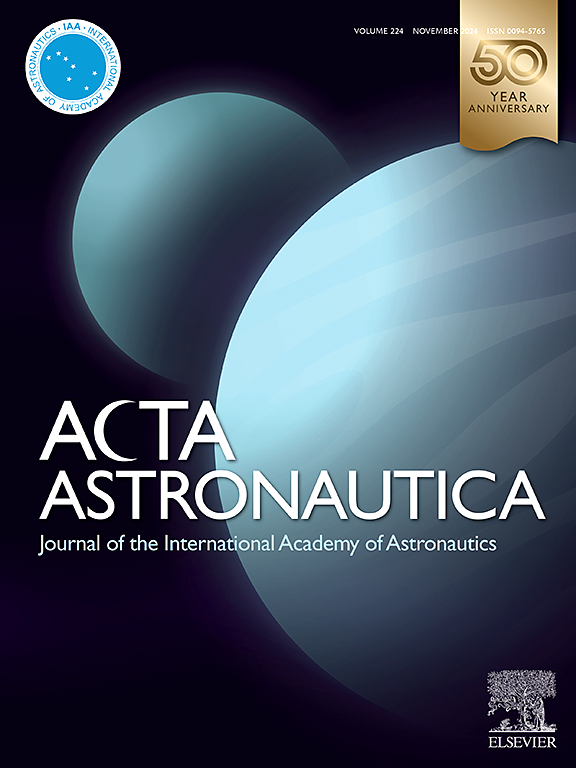Adaptive guidance for low-thrust formation flight mission in Circular Relative Orbit
IF 3.1
2区 物理与天体物理
Q1 ENGINEERING, AEROSPACE
引用次数: 0
Abstract
Spacecraft formation flight is increasingly pivotal in the design of new space missions. This demands an high level of autonomy to optimize science time, and the development of advanced mission concepts to surpass current technological limitations. Recently, Low Earth Orbit (LEO) has been explored as solution for experimental validation of novel formation flight technologies. LEO is related to proximity formation flight missions, which require active guidance algorithms to ensure mission success and safe operations. An efficient guidance algorithm is proposed to enhance the autonomy of proximity formation flight missions, enabling variable formations and reconfiguration while ensuring safety. The optimal formation trajectory problem, conceptualized as Circular Relative Orbit, addresses the relative motion with respect to a reference orbit. Rigorous Lyapunov design is proposed to ensure convergence to the desired trajectory, guaranteeing closed-loop system stability. It incorporates an Artificial Potential Field function to deal with the formation flight problem. Initial simulations are conducted to assess the effectiveness of the proposed approach within the restricted Two-Body dynamics framework. The algorithm is applied to accomplish a space interferometer deploying mission in LEO, demonstrating its efficacy through a compact implementation. Finally, the algorithm’s general and wider effectiveness is validated with elliptical and L2 Halo reference orbits.
圆形相对轨道低推力编队飞行任务的自适应制导
航天器编队飞行在新型航天任务设计中越来越重要。这需要高度的自主性,以优化科学时间,并发展先进的任务概念,以超越当前的技术限制。近地轨道作为新型编队飞行技术实验验证的解决方案,近年来得到了广泛的研究。近地飞行涉及近距离编队飞行任务,需要主动制导算法来确保任务成功和安全运行。提出了一种有效的制导算法,以提高近距离编队飞行任务的自主性,在保证安全的前提下实现编队的可变和可重构。最优编队轨迹问题,被定义为圆形相对轨道,解决相对于参考轨道的相对运动问题。提出了严格的李雅普诺夫设计,以保证收敛到期望轨迹,保证闭环系统的稳定性。该算法引入了人工势场函数来处理编队飞行问题。在受限的两体动力学框架下,进行了初步仿真以评估所提出方法的有效性。将该算法应用于低轨道空间干涉仪部署任务,通过紧凑的实现验证了算法的有效性。最后,以椭圆轨道和L2 Halo参考轨道验证了算法的通用性和广泛性。
本文章由计算机程序翻译,如有差异,请以英文原文为准。
求助全文
约1分钟内获得全文
求助全文
来源期刊

Acta Astronautica
工程技术-工程:宇航
CiteScore
7.20
自引率
22.90%
发文量
599
审稿时长
53 days
期刊介绍:
Acta Astronautica is sponsored by the International Academy of Astronautics. Content is based on original contributions in all fields of basic, engineering, life and social space sciences and of space technology related to:
The peaceful scientific exploration of space,
Its exploitation for human welfare and progress,
Conception, design, development and operation of space-borne and Earth-based systems,
In addition to regular issues, the journal publishes selected proceedings of the annual International Astronautical Congress (IAC), transactions of the IAA and special issues on topics of current interest, such as microgravity, space station technology, geostationary orbits, and space economics. Other subject areas include satellite technology, space transportation and communications, space energy, power and propulsion, astrodynamics, extraterrestrial intelligence and Earth observations.
 求助内容:
求助内容: 应助结果提醒方式:
应助结果提醒方式:


